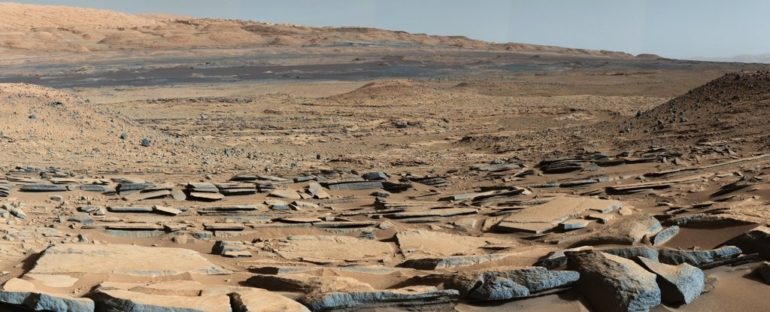When exploring alien worlds, it’s important to know exactly what you’re looking at – and a fresh analysis of rock samples taken from the Gale crater on Mars suggests this ancient grit might not be the lake sediment we thought it was.
According to a new study on the chemistry of the crater’s sediments, the rocky deposits – picked up by the Curiosity rover over the last nine years or so – are more likely the result of airborne particles being blown into the crater, before being cemented in place by purely atmospheric conditions.
The team behind the new research argues that the chemical elements found in these samples – the ones that have survived across billions of years – don’t match up with what would be expected from an ancient lake environment.
Mount Sharp in the Gale crater. (NASA’s Mars Curiosity Rover)
“The key point is that some elements are mobile, or easy to dissolve in water, and some elements are immobile, or in other words, they stay in the rocks,” says planetary geologist Joe Michalski from the University of Hong Kong.
“Whether an element is mobile or immobile depends not only on the type of element but also on the properties of the fluid.”
Through a combination of chemical measurements, X-ray diffraction (XRD), and texture analysis, the team found evidence of a type of erosion that goes against the large lake hypothesis, hinting that most of the sediments were laid down in much drier conditions.
Airborne dust and volcanic ash most likely make up the majority of the deposits, according to the researchers, with later weathering coming from rainfall or from ice melt. Only a small fraction of sediments fully match up with having been formed beneath a lake.
The new analysis points to immobile chemical elements that are strongly correlated with higher elevations, which in turn could be evidence that the water coverage in the Gale crater was much shallower and more transitory than had been assumed.

Above: How water may have filled the Gale crater as outlined by the lake hypothesis (left) and the new hypothesis (right).
“This points toward top-down weathering as you see in soils,” says Michalski. “Further, [the study] shows that iron is depleted as weathering increases, which means that the atmosphere at the time was reducing on ancient Mars, not oxidizing like it is on the modern day, rusted planet.”
The Gale crater was chosen as the landing site for Curiosity when it dropped down from space in 2012, because it was thought that it held a lake several billion years ago. Since then, it’s spent more than 3,000 Martian days (or sols) studying rocks.
As well as changing our sediment analysis approach, this could also shift scientific thinking on how the Martian climate has changed across the eons – there might have been frequent, temporary periods of wetness rather than one extended one, for example. That also has implications for figuring out whether or not life ever existed on the planet.
However, it’s worth remembering just how difficult it is to piece together the origins of the Gale crater. We’re not just looking back billions of years, we’re also peering across millions of kilometers – and it’s likely that there’s much more to come from Curiosity and the rocks it gathers.
“This is one of the big limitations of trying to do remote sensing and doing science on other planets,” planetary scientist Tanya Harrison from imaging company Planet Labs, who wasn’t involved in the study, told Inverse.
“We get ambiguous data a lot of the time that could point to multiple ideas.”
The research has been published in Science Advances.



